Producer(s) Yasuhiro Wada Composer(s) Tsuyoshi Tanaka Initial release date 9 August 1996 | Artist(s) Kenji Koyama Mode(s) Single-player Series Story of Seasons | |
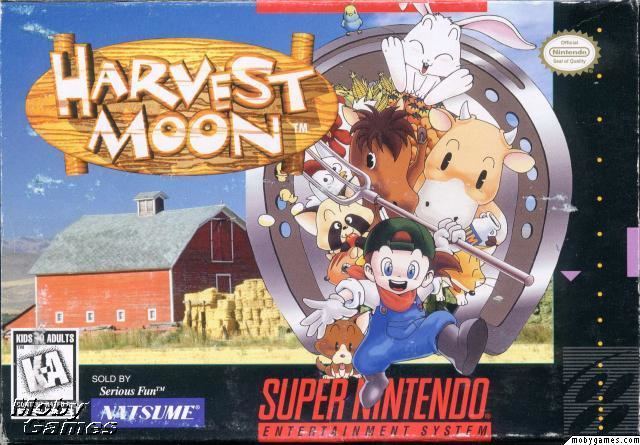 | ||
Director(s) Setsuko MiyakoshiKen Takahashi Genres Simulation game, Role-playing game Similar Story of Seasons games, Natsume games, Role-playing games | ||
Harvest Moon (牧場物語, Bokujō Monogatari, lit. "Farm Story") is a farm simulation role-playing game developed by Amccus for the Super Nintendo Entertainment System. The game first released in Japan in 1996, in North America in 1997, and in Europe in 1998. The European version shipped with language localizations for Germany and France. It is the first game in the long-running Story of Seasons series, previously known as the Harvest Moon series in western territories. The game has been re-released on the Satellaview and the Wii and Wii U Virtual Consoles.
Contents
- Gameplay
- Overworld
- Seasons and time
- Income
- Tools
- Animals
- Marriage
- Special events
- Localization
- Satellaview version
- Reception
- References
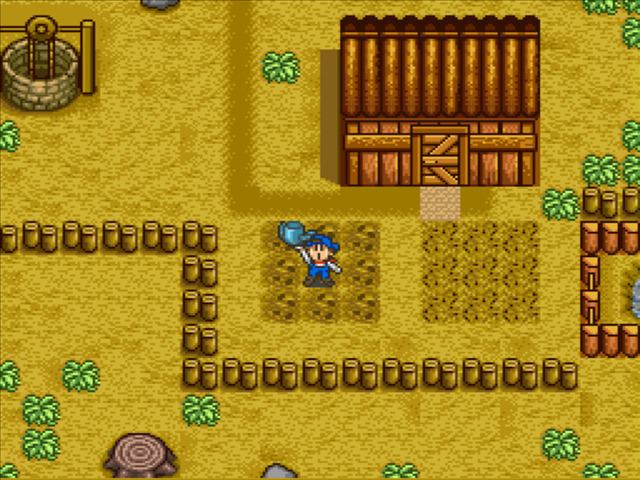
Gameplay
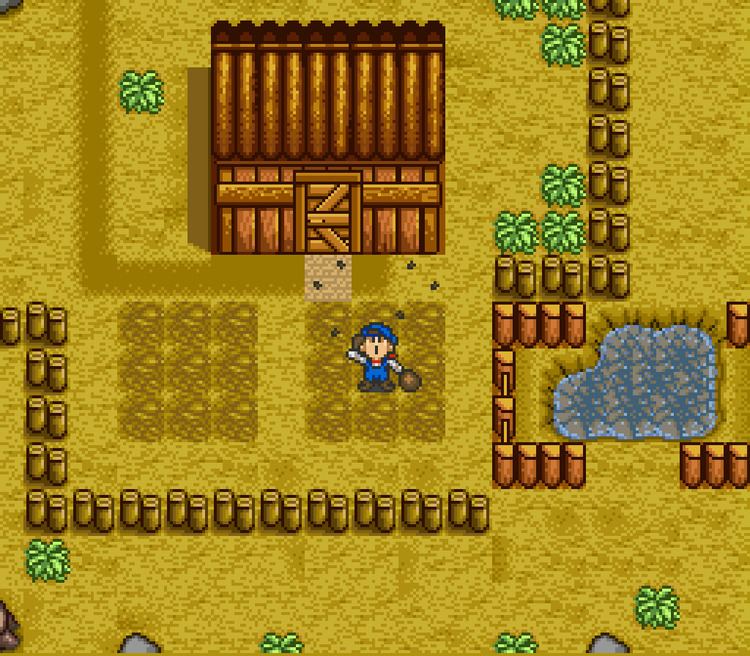
The original SNES game follows a young boy charged with maintaining his absent father’s farm, although later releases allow the player to choose a male or female character. In both Harvest Moon: More Friends of Mineral Town for Nintendo’s Game Boy Advance and Harvest Moon: Another Wonderful Life for Nintendo’s GameCube the character is exclusively female. The primary objective of the Harvest Moon video game series is to restore and maintain a farm that has fallen into disrepair. The player decides how to allocate time between daily tasks, such as farming, raising livestock, fishing, and foraging.
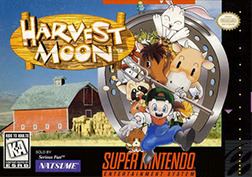
For vegetables to develop, they must receive water each day; lack of water does not kill crops, but prevents them from growing. Animals must be fed once a day to keep them producing. While the only care that chickens require is feeding, cows must be continually talked to, brushed, and milked to retain their health. A cow may become sick if not fed for a day and, if untreated, sickness can lead to death. Chickens may die if left outside, where they can be blown away in a storm or eaten by wild dogs. After dark, the only business in town that the player can access is the bar, where a number of non-player characters gather to drink and talk.
Overworld

The overworld is humid subtropical, and changes as the seasons and weather patterns do (i.e. snow during winter, rain, etc.). It consists of three main areas: the player's farm, the town, and the mountain. Bad weather, such as rain, forces the villagers and people on the mountainside to go indoors, so the player has to go inside to talk to them.
Seasons and time
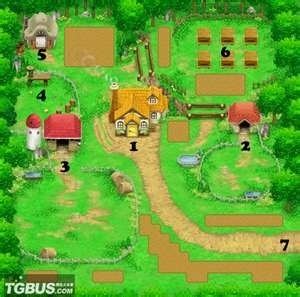
Each year has four thirty-day seasons, and each day lasts from 6 a.m. to 6 p.m, when it becomes dark and the clock stops. Unlike in later Harvest Moon games, the player can effectively stay outside as long as they want without any penalty to stamina. However, when married, the character loses a few affection points with their spouse if they come home after 6 p.m. unless married to Eve.
Income

The player can farm vegetables during the spring and summer. During fall, the only things that grow are mushrooms—a normal one and a poisonous one—in the Forest, and the hay grass, and in winter, nothing grows but the herbs in the forest cave, which grow all year round. Crops, eggs, and milk can be placed in collection boxes, from which a shipper will collect them at 4 or 5 p.m. each day, the player being paid the next morning. The player can also gather herbs and wild fruit in the forest, and fish from a small pond.
Tools
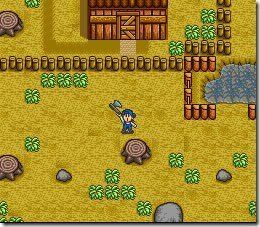
The player starts with basic tools, such as a watering can, axe, hoe, sickle, seeds, and hammer. All these tools can be upgraded if the player completes certain side quests (although the watering can's improvement must be purchased). Only two items can be carried at a time.
Animals
At the beginning of the game, the player adopts a dog, though it requires no special care and its only contribution to the game is barking to warn the player that the farm's fence requires fixing. The player must also hug (pick up) the dog at least 100 times during the game to receive the best ending. In the winter of the first year, the player also adopts a horse, which can be used as a portable collection box.
The barn and henhouse are each capable of holding up to twelve of their respective animals. Cows are purchased from a livestock dealer in town, as is at least one chicken. Additional chickens can be hatched by placing an egg in an incubator instead of selling it. Cows can be bred by purchasing a Miracle Potion from the livestock dealer, which will make a cow pregnant, giving birth after 21 days to a newborn calf that is smaller than purchased calves. However, due to the cost of the potion and the lost productivity, it is more efficient to buy calves. Cows, when first purchased or born, require time to grow before they can be milked; afterward, they grow larger and produce greater quantities of milk. Fully developed chickens and cows can be sold for profit.
Marriage
A player can marry a number of the non-player-characters populating the towns of Harvest Moon. Marriage requires characters to be of the opposite gender and that the non-player-character have a high level of affection for the player. Affection is raised by in game courtship, and is measured by a heart or flower gauge, depending on the game version. Courtship involves discovering the specific game items a bachelor or bachelorette desires, and then offering these items as gifts. The player may have to expand his/her house, purchase a double sized bed, and purchase a blue feather for proposal. Once the player reaches the bachelorettes or bachelor’s highest heart/flower gauge and completes all the necessary requirements, they will be able to marry them.
Special events
At certain points in the game, the player has the opportunity to take part in side quests that provide benefits. There are a number of events (some scheduled, some not) that add to the gameplay:
Some of the game's special events require natural disasters to allow the player to access it. After an earthquake or lightning strike, for example, the player can meet the "Harvest Sprites" who live in tunnels under the farm. They can also gain access to a pond where the Harvest Goddess lives. Doing these things allows the character to upgrade his tools without paying money.
Localization
In the localized North American version, all references to alcohol are changed to "juice," even though anyone who drinks said "juice" clearly becomes intoxicated. While many elements of the game were "westernized" for its American release, some Japanese cultural elements were overlooked. For example, townspeople sometimes discuss the church and its religion in Shinto terms, such as referring to the existence of both a "God of the Harvest" and a "God of Business." In several "New Day" cinematic sequences, the character eats an onigiri, a traditional Japanese food item. The news anchor on TV in the game bows to the audience in a welcoming manner, which is uncommon in western countries.
Satellaview version
BS Bokujō Monogatari (BS 牧場物語) was an episodically released ura- or gaiden-version of the original Harvest Moon consisting of 4 unique episodes on the Satellaview. Each episode had to be downloaded by players from St.GIGA (at NikoNiko Ranch on the BS-X cartridge) during a specified broadcast week and during a specified time-window. It featured "SoundLink" narration (radio drama-style streaming voice data intended to guide players through the game and give helpful hints and advice). Due to the nature of SoundLink broadcasts these games were only broadcast to players between 6:00 and 6:50PM on broadcast dates. The game was never released outside Japan and as with all other Satellaview titles it has never been re-released as a stand-alone title. Online Satellaview emulation enthusiasts refer to the game unofficially as "BS Makiba Monogatari."A single rerun of the broadcasts was conducted in the same weekly format from November 4, 1996 to November 30, 1996 at 5:00 to 5:50PM. The BS-X download location changed to Bagupotamia Temple. The episodes were known as:
Reception
The game received mainly positive reviews and has a GameRankings standing of 73%.
For the release of Harvest Moon on the Wii's Virtual Console, IGN rated the game at 8.5, praising the game's still gorgeous 16-bit graphics and addictive gameplay.
According to Natsume's Adam Fitch, the game sold "a decent amount for that time".
